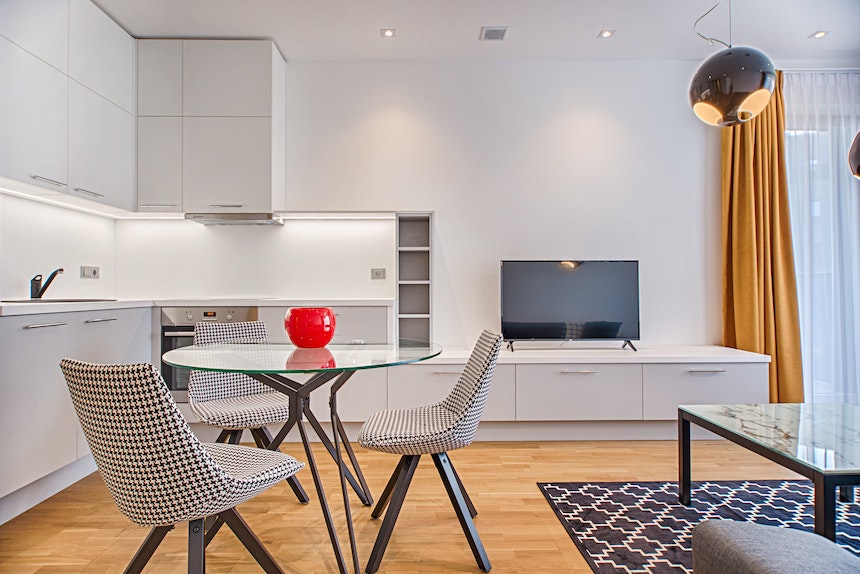
If you live in a small space or want to create a more dynamic interior design, embracing versatility is the way to go. With a versatile space, you’ll be able to use one room for multiple purposes. Whether it’s a home office that moonlights as a guest bedroom or kitchen with a built-in arts and crafts station, versatility and design can make your home feel truly personal.
Play with Layout
Try moving things around and seeing how they impact the feel and function of a room. You should consider space, movement, and flow when renovating your home layout. Avoid pushing any furniture against the wall, and create balance by arranging furniture in large and small pieces in harmony.
If you have a slightly bigger space, you can break the space into zones. One zone may serve as a study area while another may serve as a living room or entertaining area. You can divide the room into different zones subtly using rugs and furniture orientation. Just remember that as the zones are still in the same room, the color schemes and styles should still flow and complement each other.
Optimize Function
You need to maximize the space you have and make it multi-functional. If your space is small, it’s important to incorporate pieces that do more than one job. Storage units that can function as a desk. Built-in pantries and bookcases can do wonders to open up a floor plan to give the illusion of more space.
Space-saving furniture is also a good idea when you have a tiny space, or simply want to declutter. There are many innovative furniture options these days that combine storage with function, design or both.
Make sure that your furniture fits the space you’re decorating. Far too often, we choose furniture based on personal preference and not on what is best for space. The result usually ends up being a space that houses furniture too large for the parameter, which makes it crowded and uncomfortable.
Find ways to incorporate personal style with furniture that’s suited for space. Many times, you can find smaller replicas of your favorite pieces that are better suited for your home.
Seek Out Unique Pieces
There are so many furniture and décor options out there, and redesigning a room is the perfect time to experiment with them. Look for unique pieces that can make a room pop. The key is to choose pieces that can make a statement without going overboard or taking over the room. A unique painting that has the same colors as your furnishings or a sofa cover with a bold print are both good ways to add interest without overwhelming the other décor.
You can find a lot of unique pieces at both the furniture store and the thrift shops or garage sales. Likely, you’ll want to get most of your furnishings at the store but stay on the lookout for things that would fit wherever you go.
If you’re worried about the cost of redesigning or redecorating a room, look at the décor and furnishings you already have. Decide if there are any pieces you want to keep and design the room around those. If you still love that dark brown couch you’ve had for years, there’s no reason to get rid of it. Just find some new complementary furnishings and décor. You’d be surprised what you can find that will fit any budget.
Experiment with Combinations
Never feel like you have to stick to a certain conventional design style. For instance, you can find ways to create a space that serves as your office and a special place to kick back and relax. Big, comfy pillows in a book nook combined with a sleek desk break up an otherwise stale workstation and instead, make it warm and inviting. The focus should be on the versatility of the room and how you can incorporate your favorite pieces.
You can also experiment with colors and details. Spend some time putting mixing and matching different combinations of colors and seeing what you like together. You might already know that you like blue and gray together but then realize that adding a yellow accent brightens the room. If you have a living room that is mostly brown, either red or green would work well to make the room feel more vibrant. There are hundreds of color combinations to try. Just keep the purposes of the room in mind as you do.
If you’ve got a small or open-concept space, you need to learn how to make the space versatile. Creating a versatile space doesn’t need to cost a fortune, though. While it’s a good idea to have high-quality furniture that will last, you don’t have to break the bank to create the space of your dreams. Start with what you have, and get creative as you find new ways to optimize and maximize your living space.
- 7 Ways To Become a Better Athlete - March 2, 2024
- 5 Tips for Economically Buying Your First Car - February 22, 2024
- Feeling Overwhelmed? How Cleaning Out Your Home Can Help - November 28, 2023






